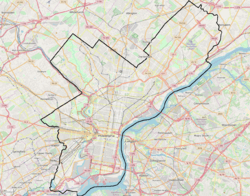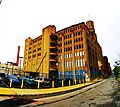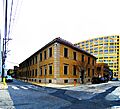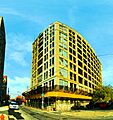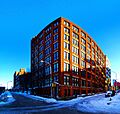Callowhill Industrial Historic District facts for kids
Quick facts for kids |
|
|
Callowhill Industrial Historic District
|
|
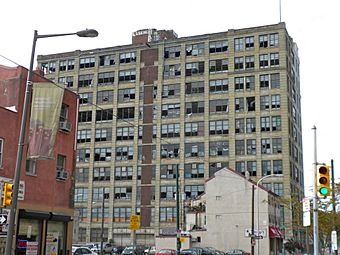
Wood and 12th, Callowhill Industrial Historic District, August 2010
|
|
| Location | Roughly bounded by Pearl St., North Broad St., Hamilton St., and the Reading Railroad Viaduct, Philadelphia, Pennsylvania |
|---|---|
| Area | 5.7 acres (2.3 ha) |
| Architect | William Steele & Sons; Ballinger & Perrot; Tyre, Philip; Wilson, Joseph; Wilson Brothers & Co.; Kahn, Albert; Stuckert & Co.; Johnson, Philip; Stearns & Castor |
| NRHP reference No. | 10000403 |
| Added to NRHP | June 28, 2010 |
The Callowhill Industrial Historic District is a special area in the Callowhill neighborhood of Philadelphia, Pennsylvania. It's called a "historic district" because it has many old buildings that are important to history.
This district includes 31 main buildings, one historic site, and one structure. Most of these buildings were built between the 1890s and the 1930s. They show us what factories and businesses looked like a long time ago.
Contents
What is the Callowhill Industrial Historic District?
A historic district is like a special neighborhood. It is protected because its buildings tell a story about the past. The Callowhill Industrial Historic District is recognized by the United States government. This means it's a place worth preserving for future generations.
What Kind of Buildings Are There?
The buildings in this district are mostly commercial and industrial. This means they were used for businesses, offices, or factories. They are usually between 4 and 14 stories tall. Their outside walls are made from brick, concrete, terra cotta, and stone.
Many of these buildings are shaped like big boxes. They are called "mid-rise loft buildings" and have flat roofs. You can also find eleven older brick rowhouses in the district. Some of these homes date back to the 1830s.
Why Are These Buildings Special?
Many buildings in the Callowhill Industrial Historic District are famous. The Rebman Building, built in 1903, is one example. The Stewart Cracker Building, from around 1900, is another. Other notable buildings include the U.S. Tire Company Building (1911) and the Lasher Building (1927). The old Philadelphia City Morgue (1928) and the Overland Motor Company Building (1910) are also part of this history.
Some buildings in the district are so important they are listed separately. These include the Smaltz Building (1912), the Terminal Commerce Building, the Goodman Brothers and Hinlein Company, and the Packard Motor Corporation Building. Each of these has its own unique story.
What Happened to Some Buildings?
Sadly, some historic buildings in the district have been torn down. The Overland Motor Company Building was demolished in 2012. This was done to make space for a new dance center for The Pennsylvania Ballet. In 2018, the U.S. Tire Company Building was also taken down.
When Was It Recognized?
The Callowhill Industrial Historic District was officially added to the National Register of Historic Places in 2010. This list helps protect important places across the country. It makes sure their history is remembered.
Images for kids


